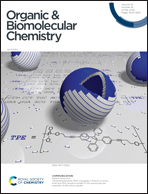Identification of parallel medicinal chemistry protocols to expand branched amine design space†
Abstract
α-Branched heteroaryl amines are prevalent motifs in drugs and are typically prepared through C–N bond formation. In contrast, C–C bond-forming approaches to branched amines may dramatically expand available chemical space but are rarely pursued in parallel format due to a lack of established library protocols. Methods for the synthesis of α-branched heteroaryl amines via aldimine addition have been evaluated for compatibility with parallel synthesis. In situ activation of aliphatic carboxylic acids as redox-active esters enables Zn-mediated decarboxylative radical imine addition to access aliphatic-branched heterobenzylic amines. In situ activation of (hetero)aryl bromides via Li–halogen exchange enables heteroaryl–lithium addition to imines to access (hetero)benzhydryl amines. Condensation of heteroaryl amines with heteroaryl aldehydes provides aldimines which may be intercepted with aryl Grignard reagents to provide modular access to (hetero)benzhydryl amines. These protocols minimize synthetic step count and maximize accessible design space, enhancing access to α-branched heteroaryl amines for medicinal chemistry.



 Please wait while we load your content...
Please wait while we load your content...